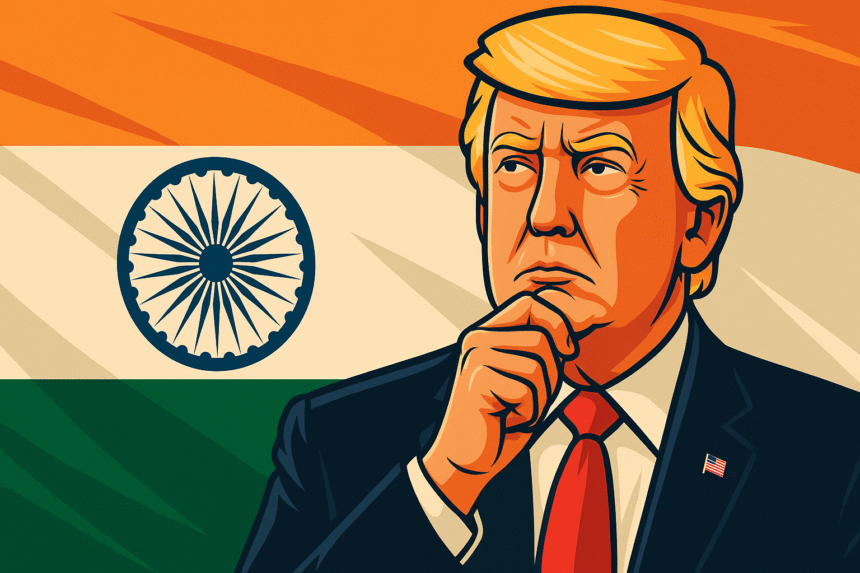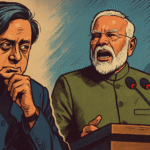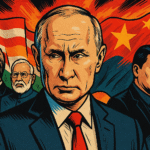When trade policy meets drama, the headlines write themselves. Recently, former U.S. President Donald Trump dropped a tariff bombshell: India may soon face a 20–25% tariff on its exports to the United States. Though slightly lower than the previously threatened 26%, it’s still enough to send shivers through boardrooms and stock markets.
As temperatures rise in global markets, both nations are racing toward a self-imposed August 1 deadline to finalize a trade agreement. Let’s unpack the deal—or the tension—in crisp, impactful prose.
🤝 A Carefully Chosen Friend
Trump called India a “good friend”—but added a pointed reminder: “India has charged more tariffs than almost any other country”. What that meant was clear: tariffs have been high, and now it’s U.S. turn to respond.
In effect, India may pay a bit less than others—Trump hinted at 20–25%, compared to 26% initially floated. But the key line was: the final number hasn’t been agreed yet. It’s negotiation season—with stakes high and the clock ticking.
📆 Deadline Drama: August 1 in Sight
The date etched in bold on economists’ and diplomats’ minds: August 1. That’s when Trump’s reciprocal tariff policy could take effect. If no deal seals the gap, higher duties could impact hundreds of billions in trade.
India is aiming for a larger bilateral pact—symbolically called “Mission 500”—targeting $500 billion in trade by 2030. But first, both sides need to agree terms before tariff bombs explode.
📉 Why 20–25% Matters (Even If It’s Lower)
At face value, paying slightly less than others might sound like a concession win. Yet, the impact is massive:
- Tariffs at this level nearly wipe out margins on goods like pharmaceuticals, machinery, gems, auto parts, and textiles.
- Nearly 87% of India’s exports to the U.S. could be affected, spanning sectors worth over $60–70 billion annually.
- Analysts estimate India might lose $7 billion or more in export value each year if tariffs go into full effect without offsets.
Simply put, reduced isn’t safe. It’s just slightly less painful.
🌐 Where India Stands in Global Trade
India’s trade tariffs average around 12%, while U.S. tariff norms hover near 2.2%. That imbalance has driven Trump’s criticism, calling India a “tariff king”. Even though India and the U.S. are strategic partners, this friction has added tension.
The proposed tariffs are part of Trump’s “Liberty Day” framework—designed to penalize countries with high barriers while forcing them to open markets. India now stands at the center of this plan.
✨ Diplomacy in Action: Modi, Trump & Trade Talks
In February 2025, Indian Prime Minister Narendra Modi visited Washington for high-level talks. The duo discussed Mission 500, strategic partnerships, defense agreements—and tariffs topped the agenda.
Coming from that meeting is a cautious hope: trade talks continue, India may offer tariff concessions in return for less U.S duties, and both sides remain engaged.
But trade is a tough game. Both sides need to walk the balance—diplomacy over derision, numbers over slogans.
📊 Visualizing the Tariff Picture
| Factor | Details |
|---|---|
| Proposed Tariff Rate | 20%–25% (under negotiation) |
| Effective from | August 1 (if no deal) |
| Sectoral Impact | ~87% of India’s exports to U.S. |
| Trade Loss Estimate | $7 billion+ annually |
| Negotiation Deadline | August 1, 2025 |
| Target Bilateral Deal | Mission 500 for trade by 2030 |
Even a small shift in tariff percentage changes hundreds of billions in trade—and thousands of jobs and factories on both sides.
🎯 What Indians Need to Watch
- Exporters of pharma, engineering products, and gems stand to lose the most.
- Rupee markets may take a dip amid uncertainty.
- Negotiators must secure lower reciprocal tariff rates in return for opening markets in sectors like energy, defense, and technology.
- Long-term trust-building beyond tariffs—which can help stabilize India–U.S. ties going forward.
🤔 Final Thoughts: Trade in the Age of Tariffs
Trump’s hint of India tariffs lower than those of other nations might feel like a relief—but it’s not a free pass. Even a 20% duty can tip the scales against Indian exporters and shift global supply chains. The only solution? A balanced trade agreement that reduces friction, not magnifies it.
Negotiators now must deliver: fast. Because in the world of trade, deadlines matter—and numbers speak louder than words.
India may be a “good friend,” but friends must negotiate smart to keep trade strong under pressure.












